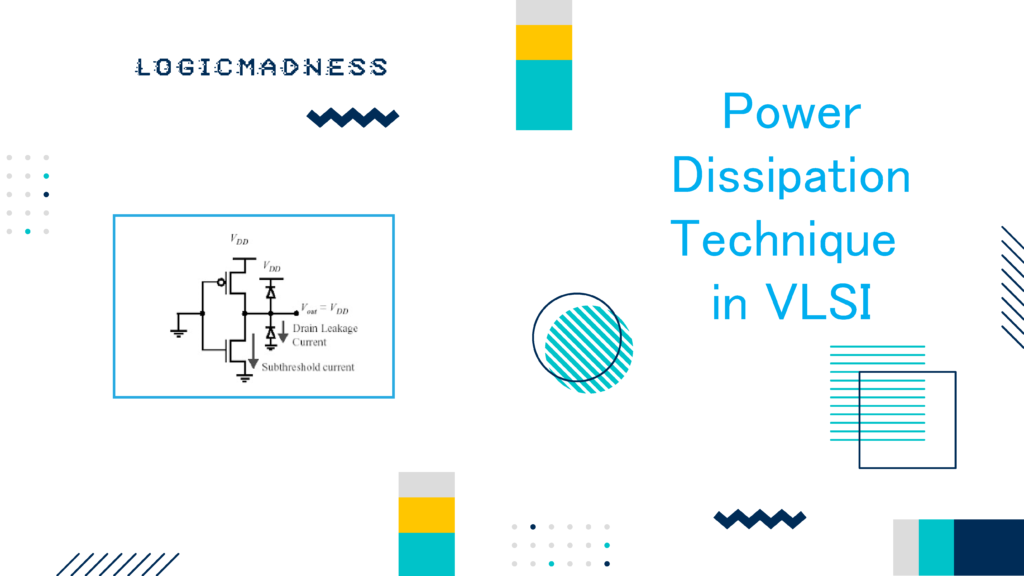Power dissipation in Very Large Scale Integration (VLSI) circuits is a critical concern for designers. This guide explores the different types of power dissipation, their sources, and effective power management techniques to enhance performance while reducing energy consumption.
Types of Power Dissipation
Power dissipation in VLSI circuits can be classified into two main categories:
| Type of Power | Description |
| Static Power | Power consumed when the circuit is inactive or in a quiescent state, primarily due to leakage currents. |
| Dynamic Power | Power consumed during circuit operation, influenced by switching activity and capacitance. |
Static Power Dissipation
Static power is consumed when there is no circuit activity, which occurs even without input changes or clock signals. The primary cause of static power dissipation is leakage currents, which flow when transistors are in the off state.
Leakage Current Types:
- Reverse Bias Leakage Current: Occurs when junction diodes within the transistors are reverse biased.
- Sub-threshold Leakage Current: Flows from drain to source when the gate-source voltage (VGS) is lower than the threshold voltage (Vth).
The relationship can be summarized as follows:
- Static Power Dissipation (Psta) ∝ 1/Vth
Dynamic Power Dissipation
Dynamic power is consumed when the circuit is operational. It comprises two main components:
- Switching Power: Resulting from the charging and discharging of load capacitance during state changes.
- Formula: Pswitch=α⋅(Vdd)2⋅CL⋅f
- where:
- α = switching activity
- Vdd = supply voltage
- CL = load capacitance
- f = frequency of operation
- Short-Circuit Power: Occurs when transistors in the pull-up and pull-down networks are turned on simultaneously during input transitions, causing a short-circuit path.
Reducing Power Dissipation
To minimize power dissipation, designers can adjust the following parameters:
| Parameter | Impact on Dynamic Power |
| Switching Activity (α) | Lowering reduces power consumption |
| Supply Voltage (Vdd) | Lowering decreases power but may increase delay |
| Load Capacitance (CL) | Reducing decreases power dissipation |
| Frequency of Operation (f) | Lowering reduces power |
Delay Considerations
The delay associated with transistor operation is dependent on both the supply voltage (Vdd) and the threshold voltage (Vth). Using high Vth transistors can save static power but may introduce more delay, affecting circuit performance.
Common Power Management Techniques
Here are some effective power management techniques used in VLSI design:
Multi Vth Design
In this technique, different standard cells with varying threshold voltages (Vth) are utilized. The goal is to balance performance and power consumption.
| Cell Type | Threshold Voltage (Vth) | Power Consumption | Performance | Usage |
| HVT | High | Low | Slow | Non-critical paths |
| SVT | Medium | Moderate | Moderate | General usage |
| LVT | Low | High | Fast | Timing-critical paths |
Bus Encoding
Bus encoding techniques can significantly reduce power dissipation during data transmission. By minimizing transitions, the switching activity is lowered.

Types of Encoding:
| Encoding Type | Description | Example |
| Non-redundant | Maps n-bit code to n-bit code | Gray coding |
| Redundant | Maps n-bit code to m-bit code (m > n) | One-hot coding |
Hardware-Software Tradeoff
Deciding which components to implement in hardware (HW) and which in software (SW) can optimize power consumption.
| Approach | Speed | Cost | Power Consumption |
| HW-based | Fast | Higher | More power |
| SW-based | Slower | Lower | Less power |
Multiple Vdd Design
Lowering supply voltage can significantly reduce power consumption, but it can also increase delay.
- Static Voltage Scaling: Different circuit blocks operate at varying voltages, with regulators creating separate voltage supplies.
- Dynamic Voltage and Frequency Scaling (DVFS): Adjusts voltage and frequency based on workload to optimize power consumption.
Clock Gating
Clock gating reduces power consumption by disabling the clock to inactive blocks, thereby preventing unnecessary power dissipation.
Power Gating
Power gating takes it a step further by completely turning off the power supply to inactive blocks, saving both leakage and dynamic power. However, the latency incurred in powering up blocks must be considered.
Conclusion
Effective power management in VLSI circuits is crucial for improving performance and efficiency. By understanding the types of power dissipation and employing various power management techniques, designers can create systems that not only perform well but also consume less energy.

